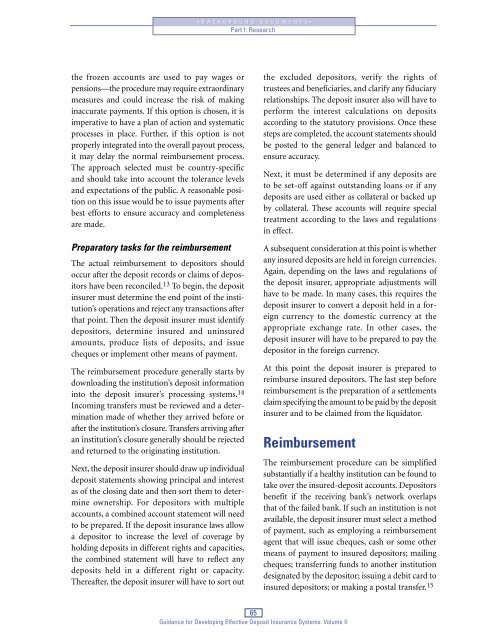Volume II - PDF - International Association of Deposit Insurers
Volume II - PDF - International Association of Deposit Insurers
Volume II - PDF - International Association of Deposit Insurers
- No tags were found...
Create successful ePaper yourself
Turn your PDF publications into a flip-book with our unique Google optimized e-Paper software.
•BACKGROUND DOCUMENTS•<br />
Part I: Research<br />
the frozen accounts are used to pay wages or<br />
pensions—the procedure may require extraordinary<br />
measures and could increase the risk <strong>of</strong> making<br />
inaccurate payments. If this option is chosen, it is<br />
imperative to have a plan <strong>of</strong> action and systematic<br />
processes in place. Further, if this option is not<br />
properly integrated into the overall payout process,<br />
it may delay the normal reimbursement process.<br />
The approach selected must be country-specific<br />
and should take into account the tolerance levels<br />
and expectations <strong>of</strong> the public. A reasonable position<br />
on this issue would be to issue payments after<br />
best efforts to ensure accuracy and completeness<br />
are made.<br />
Preparatory tasks for the reimbursement<br />
The actual reimbursement to depositors should<br />
occur after the deposit records or claims <strong>of</strong> depositors<br />
have been reconciled. 13 To begin, the deposit<br />
insurer must determine the end point <strong>of</strong> the institution’s<br />
operations and reject any transactions after<br />
that point. Then the deposit insurer must identify<br />
depositors, determine insured and uninsured<br />
amounts, produce lists <strong>of</strong> deposits, and issue<br />
cheques or implement other means <strong>of</strong> payment.<br />
The reimbursement procedure generally starts by<br />
downloading the institution’s deposit information<br />
into the deposit insurer’s processing systems. 14<br />
Incoming transfers must be reviewed and a determination<br />
made <strong>of</strong> whether they arrived before or<br />
after the institution’s closure. Transfers arriving after<br />
an institution’s closure generally should be rejected<br />
and returned to the originating institution.<br />
Next, the deposit insurer should draw up individual<br />
deposit statements showing principal and interest<br />
as <strong>of</strong> the closing date and then sort them to determine<br />
ownership. For depositors with multiple<br />
accounts, a combined account statement will need<br />
to be prepared. If the deposit insurance laws allow<br />
a depositor to increase the level <strong>of</strong> coverage by<br />
holding deposits in different rights and capacities,<br />
the combined statement will have to reflect any<br />
deposits held in a different right or capacity.<br />
Thereafter, the deposit insurer will have to sort out<br />
the excluded depositors, verify the rights <strong>of</strong><br />
trustees and beneficiaries, and clarify any fiduciary<br />
relationships. The deposit insurer also will have to<br />
perform the interest calculations on deposits<br />
according to the statutory provisions. Once these<br />
steps are completed, the account statements should<br />
be posted to the general ledger and balanced to<br />
ensure accuracy.<br />
Next, it must be determined if any deposits are<br />
to be set-<strong>of</strong>f against outstanding loans or if any<br />
deposits are used either as collateral or backed up<br />
by collateral. These accounts will require special<br />
treatment according to the laws and regulations<br />
in effect.<br />
A subsequent consideration at this point is whether<br />
any insured deposits are held in foreign currencies.<br />
Again, depending on the laws and regulations <strong>of</strong><br />
the deposit insurer, appropriate adjustments will<br />
have to be made. In many cases, this requires the<br />
deposit insurer to convert a deposit held in a foreign<br />
currency to the domestic currency at the<br />
appropriate exchange rate. In other cases, the<br />
deposit insurer will have to be prepared to pay the<br />
depositor in the foreign currency.<br />
At this point the deposit insurer is prepared to<br />
reimburse insured depositors. The last step before<br />
reimbursement is the preparation <strong>of</strong> a settlements<br />
claim specifying the amount to be paid by the deposit<br />
insurer and to be claimed from the liquidator.<br />
Reimbursement<br />
The reimbursement procedure can be simplified<br />
substantially if a healthy institution can be found to<br />
take over the insured-deposit accounts. <strong>Deposit</strong>ors<br />
benefit if the receiving bank’s network overlaps<br />
that <strong>of</strong> the failed bank. If such an institution is not<br />
available, the deposit insurer must select a method<br />
<strong>of</strong> payment, such as employing a reimbursement<br />
agent that will issue cheques, cash or some other<br />
means <strong>of</strong> payment to insured depositors; mailing<br />
cheques; transferring funds to another institution<br />
designated by the depositor; issuing a debit card to<br />
insured depositors; or making a postal transfer. 15<br />
65<br />
Guidance for Developing Effective <strong>Deposit</strong> Insurance Systems: <strong>Volume</strong> <strong>II</strong>
















